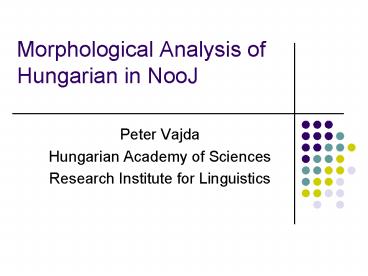Morphological Analysis of Hungarian in NooJ - PowerPoint PPT Presentation
1 / 19
Title:
Morphological Analysis of Hungarian in NooJ
Description:
Morphological Analysis of Hungarian in NooJ. Peter Vajda. Hungarian Academy of ... grammatical relations which are expressed by prepositions in French/English) ... – PowerPoint PPT presentation
Number of Views:29
Avg rating:3.0/5.0
Title: Morphological Analysis of Hungarian in NooJ
1
Morphological Analysis of Hungarian in NooJ
- Peter Vajda
- Hungarian Academy of Sciences
- Research Institute for Linguistics
2
Summary
- Hungarian morphology
- Linguistic resources
- Some experiments with INTEX/NooJ
- The solution
- Examples
- Derivation
3
Hungarian morphology
- Agglutinative (and sometimes inflectional)
- The suffixes
- Can have many forms (vowel harmony)
- Can change the form of the stem (there are groups
of variants) - bokor (sg.) ? bokr ok (pl.) alma (sg.) ?
almá k (pl.) - Sometimes begin with a linking vowel
- plural -k / -ak / -ek / -ok / -ök
- A noun (adj., num.) can have 7-800 forms
- A verb can have 80 forms
- Orthography there are difficulties, when
digraphs are doubled - cs ? cscs ? ccs, gy ? gygy ? ggy
4
Nominal inflections
- 18 cases (nominative, accusative, dative
grammatical relations which are expressed by
prepositions in French/English) - Expression of the possessives by suffixes
- Which mark the number, the person, the number of
the possessed - ház-a-m, ház-a-d, ház-a (my/your/his house)
- ház-a-i-m, ház-a-i-d, ház-a-i (my/your/his
houses) - Anaphorical possessive
- A ház Péteré ? The house is Péters A házak
Péteréi ? The houses are Péters - The maximal number of inflections can be five
- barát-ai-tok-é-i-t
- (I can see) those (things) of your friends
5
Verbal inflections
- Two tenses present, past
- three modes indicative, conditional, imperative
- definite and indefinite conjugations
- Néz-ek egy asztalt ? Néz-em az asztalt
- I watch a table ? I watch the table
- one special form where the subject is in 1st
person and the object is in the 2nd - néz-lek (I watch you)
- infinitive and conjugated infinitive (sometimes
subjunctive in French)
6
The resources
- Dictionary of Hungarian inflections (Elekfi,92)
- A traditional description, profound and
exhaustive - Two dimensional classification
- Vowel harmony (3 classes) and
- complex features of the stems (stem-types,
linking vowel, etc., 55 classes) - Altogether 1700 different sub-classes
(paradigms) - systematic differences and similarities are
hidden - not convenient to use in finite-state transducers
- We have converted it into a database, where we
can retrieve all the forms from
7
The experiments with INTEX/NooJ
- Brute-force method
- We created one graph per sub-class for testing
INTEX - 1700 sub-graphs
- 45000 paths in the graphs
- Using only dictionaries (.nod)
- Dictionary of stems (70000 words)
- ház,ház,NC2Astem1NW
- Dictionary of suffixes (one million entries)
- ()ak,lt1NC2Astem1gt0,1L,N1SanaPL
- ()am,lt1NC2Astem1gt0,1L,N1SanaPSe1
- ()at,lt1NC2Astem1gt0,1L,N1SanaACC
- ()at,lt1NC2A1stem1gt0,1L,N1SanaACC
- ()amat,lt1NC2Astem1gt0,1L,N1SanaPSe1ACC
- dictionary of lexical forms (which have a zero
morpheme as suffix) - ház,ház,NanaNOM
8
The linguistic solution
- transform the database into a grammar based on
morpho-phonological features - The grammatical features of stems and morphemes
are in the dictionary - The features of the stems and the suffixes can be
unified
- Grammar
- We have to describe the order of the morphemes
- Introduce features which select from the
allomorphs
9
The order of morphemes for nominals
10
The order of morphemes for nominals
barát-a-i-tok-é-i-t
barát,N PS PL ps_2 ps_pl
ANAPi ACC
11
(No Transcript)
12
Morpho-phonological features
- To introduce features we examine the allomorphs
- HÁZ HAJÓ
- HÁZ - A HAJÓ-JA
- ház,,Nnonj hajó,,Nj
- HÁZ - AT HAJÓ - T
- ház,,Nnonjacclink hajó,,Njaccnolink
13
The dictionary
14
(No Transcript)
15
The plural and the accusative kalap - ot (hat,
SGACC) kalap - ok - at (hats, PLACC)
16
Derivation
- Can change or leave the category (POS)
- Introduce new features
- kosár kosar - ak (pl.) basket
- kosar-as kosar - as - ok (pl.) basketball
player - Simple cases are handled by graphs
- Others are listed as lemmas in the dictionary
17
Assimilation and digraphs
- some suffixes (eg. val/vel) enforce total
assimilation - LÉC VEL ? LÉCCEL
- PÉCS VEL ? PÉCCSEL
- PLÉD VEL ? PLÉDDEL
18
- Conclusion
- We have adapted the traditional description
- We have described the inflectional morphology of
Hungarian in NooJ grammars/dictionaries - Handled some of the derivational morphology
- Objectives
- Find a simpler method for derivation
- Disambiguation
- Automatic methods to expand the dictionary
- Automatic delegation of features
19
Thank you

